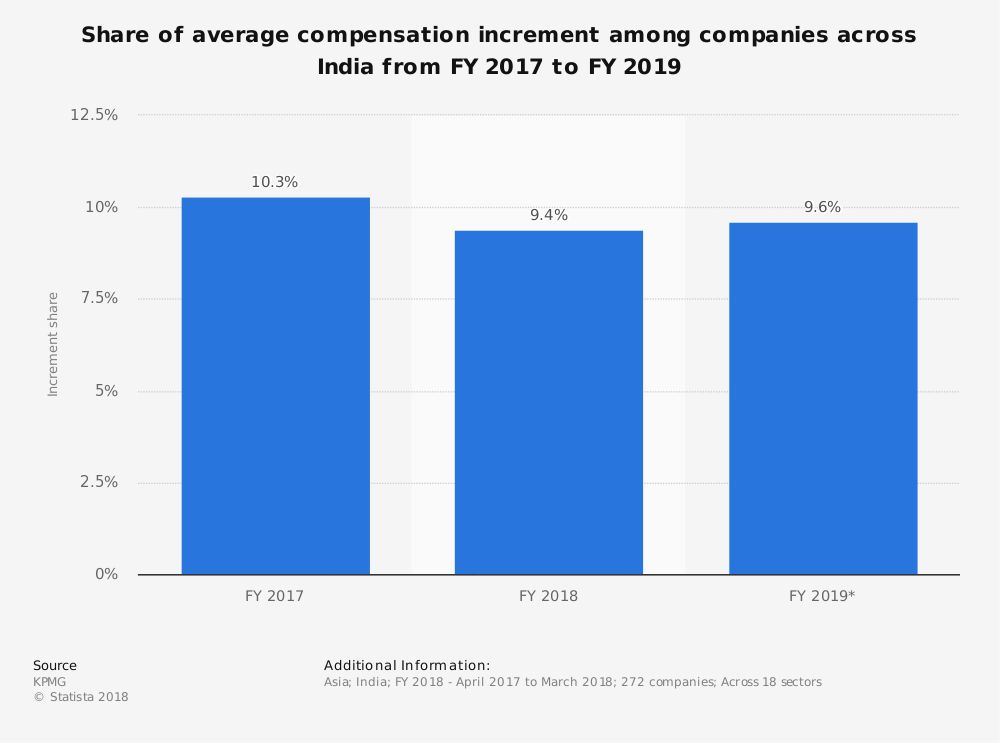
With India set to grow at a faster pace in the coming years, 79 percent of Indians believe that they will be better off in the next five years, according to Edelman Trust Barometer report 2019.
The percentage of people who are optimistic about their family's future is higher when it comes to an informed public. Nearly 88 percent of the informed Indians believe that their lives will be better off in the next five years. The table below shows the percentage of people who believe they and their families will be better off in five years' time, as per the report.
 Table: Percent who believe they and their families will be better off in five years’ time. (Source: Edelman Trust Barometer report 2019)
Table: Percent who believe they and their families will be better off in five years’ time. (Source: Edelman Trust Barometer report 2019)
The optimistic approach about the future is fuelled by higher growth forecasts by agencies such as the International Monetary Fund (IMF) (7.7 percent) and Central Statistics Office (CSO) (7.2 percent). IMF raised India's growth projection for 2019 by 10 basis points even as it cut world economic growth forecasts for 2019 and 2020, due to weakness in Europe and some emerging markets.
DATA STORY | India set to grow at a fast pace but here are its 3 biggest long-term challenges
While India's GDP growth figures hint at a faster growth pace, here are the factors that shape the positive belief of the people:
Focus on living conditions
The better forecasts mean healthy economic growth, which may pave way for improved living conditions in India. The country fared poorly in a ranking of the world's most liveable cities with New Delhi figuring at 112th and Mumbai 117th position in a list of 140 cities, according to the annual Global Liveability Index 2018 released by The Economist.
The liveability index quantifies the challenges that might be presented to an individual's lifestyle in 140 cities worldwide, and assesses which locations provide the best living conditions, the EIU said.
Last year, however, the Indian government launched its own liveability index to rate 116 Indian cities to measure the quality of life in 99 smart cities, capital cities and those with a population of over one million.
These cities were rated on parameters including local governance, social infrastructure, education, employment, health, safety, security, physical infrastructures such as housing, availability of open spaces, land use, energy, availability of water, solid waste management, and pollution.
Slideshow — Ease of Living Index: Here are the top 10 cities in India
The step indicates that the government is working towards improving the living conditions in these cities. And people believe that in a healthy economy, the government may take additional steps to ensure a better quality of life in the future.
Better employment opportunities
With India growing at the fastest rate for the second consecutive year in 2018, global giants may find interest in investing in the country. This may open more job opportunities for the citizens.
For instance, when the global US retail giant Walmart bought 77 percent of online retailer Flipkart for $16 billion, it expressed plans to create "millions of jobs through supply chains, commercial opportunity and direct employment."
India has emerged as the fourth most attractive destination for investment, according to a PwC survey 2019. "India is the rising star on the list of most attractive investment markets despite a slightly lower share of the votes," PwC said, adding it surpassed Japan last year and now it has overtaken the UK, which suffers from continuing uncertainty regarding Brexit.
While the general consensus is that with growth comes better employment, this may not hold true always. For instance, in case of India, 12 of the 17 states, which the Reserve Bank of India (RBI) categorises as 'non-special', grew faster than the national economic growth rate of 6.7 percent in fiscal 2018, but, these states failed to excel in job creation, according to a CRISIL's 'States of growth 2.0' report.
Read — India is facing a jobs data crisis: Here's how it can be fixed
In a majority of these states, growth was low in 'employment-intensive' sectors like manufacturing, construction and trade, and hotels transport and communication services, as compared to the national level, as per the report.
The employment outlook in India was also dropped by 3 percent for the October to March 2018-19 period, according to the Employment Outlook Report by staffing firm TeamLease Services. While India's gross domestic product (GDP) has been on the rise, it has failed to enthuse the job market for the forthcoming half year, as per the report. However, India fared the best compared to other markets.
The report forecasts a net employment outlook of 92 percent in H2FY19 compared to 95 percent in H1FY19.
Increase in salary
Employees in India are likely to see double-digit salary growth in 2019, according to a report by global consulting firm Korn Ferry.
Salaries in India could rise by up to 10 percent in 2019 as compared to 9 percent last year. Moreover, inflation-adjusted real-wage hikes are likely to increase to 5 percent from 4.7 percent in 2018.
Reporter's Take | Expect double digit salary hike in 2019
India would continue to enjoy the highest overall salary increases and real-wage growth in Asia, as per the report. In Asia, salaries are forecast to increase by 5.6 percent, up from 5.4 percent last year. Inflation-adjusted real-wage increases are expected to be 2.6 percent, the highest globally, but down from 2.8 percent last year.

Last fiscal, Indian employees saw their salary increase by a minimum of 10 percent and a maximum of 15 percent, according to a report by human resources firm TeamLease Services.
Back then, 9 out of 17 sectors surveyed indicated double digit growth sentiments with overall positive sentiment. Majority cities, seven out of nine, also showed a positive outlook towards salary growth. The positive outlook hinted at the possibility of a higher salary increase in the upcoming fiscal.
These factors are helping people keep a positive outlook on the future. However, we may have to wait and see if these situations improve in the next five years.
Discover the latest business news, Sensex, and Nifty updates. Obtain Personal Finance insights, tax queries, and expert opinions on Moneycontrol or download the Moneycontrol App to stay updated!